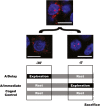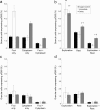Experience-dependent persistent expression of zif268 during rest is preserved in the aged dentate gyrus
- PMID: 24028087
- PMCID: PMC3848627
- DOI: 10.1186/1471-2202-14-100
Experience-dependent persistent expression of zif268 during rest is preserved in the aged dentate gyrus
Abstract
Background: Aging is typically accompanied by memory decline and changes in hippocampal function. Among these changes is a decline in the activity of the dentate gyrus (DG) during behavior. Lasting memory, however, is thought to also require recapitulation of recent memory traces during subsequent rest - a phenomenon, termed memory trace reactivation, which is compromised in hippocampal CA1 with progressive age. This process has yet to be assessed in the aged DG, despite its prominent role in age-related memory impairment. Using zif268 transcription to measure granule cell recruitment, DG activity in adult and aged animals was assessed both during spatial exploration and as animals remained at rest in the home cage in order to detect potential memory-related replay.
Results: Consistent with the observation of memory trace reactivation in DG, the probability that an individual granule cell transcribes zif268 during rest in the animal's home cage is increased by recent experience in a novel environment. Surprisingly, a comparable increase was observed in the probability of granule cells in the aged DG expressing zif268 during rest. Moreover, no significant age-related difference was observed in the number of granule cells expressing zif268 during rest. Thus, the number and pattern of granule cell expression of zif268 during rest is preserved in aged animals, despite a significant decline in exploration-related zif268 expression.
Conclusions: These data lead to the hypothesis that the input the aged DG receives from backprojections from CA3 (the region widely hypothesized to mediate reactivation) remains functionally intact despite loss of innervation from the perforant path.
Figures






Similar articles
-
Changes in task demands alter the pattern of zif268 expression in the dentate gyrus.J Neurosci. 2011 May 11;31(19):7163-7. doi: 10.1523/JNEUROSCI.0094-11.2011. J Neurosci. 2011. PMID: 21562279 Free PMC article.
-
Age-related changes in glutamate release in the CA3 and dentate gyrus of the rat hippocampus.Neurobiol Aging. 2011 May;32(5):811-20. doi: 10.1016/j.neurobiolaging.2009.05.009. Epub 2009 Jun 17. Neurobiol Aging. 2011. PMID: 19535175 Free PMC article.
-
Experience-dependent persistent Arc expression is reduced in the aged hippocampus.Neurobiol Aging. 2020 Nov;95:225-230. doi: 10.1016/j.neurobiolaging.2020.07.032. Epub 2020 Aug 4. Neurobiol Aging. 2020. PMID: 32861833
-
Corruption of the dentate gyrus by "dominant" granule cells: Implications for dentate gyrus function in health and disease.Neurobiol Learn Mem. 2016 Mar;129:69-82. doi: 10.1016/j.nlm.2015.09.005. Epub 2015 Sep 29. Neurobiol Learn Mem. 2016. PMID: 26391451 Free PMC article. Review.
-
Function of local circuits in the hippocampal dentate gyrus-CA3 system.Neurosci Res. 2019 Mar;140:43-52. doi: 10.1016/j.neures.2018.11.003. Epub 2018 Nov 5. Neurosci Res. 2019. PMID: 30408501 Review.
Cited by
-
Attenuated Late-Phase Arc Transcription in the Dentate Gyrus of Mice Lacking Egr3.Neural Plast. 2017;2017:6063048. doi: 10.1155/2017/6063048. Epub 2017 May 15. Neural Plast. 2017. PMID: 28589041 Free PMC article.
-
Locus Coeruleus Phasic, But Not Tonic, Activation Initiates Global Remapping in a Familiar Environment.J Neurosci. 2019 Jan 16;39(3):445-455. doi: 10.1523/JNEUROSCI.1956-18.2018. Epub 2018 Nov 26. J Neurosci. 2019. PMID: 30478033 Free PMC article.
-
Context-Dependent Egr1 Expression in the Avian Hippocampus.PLoS One. 2016 Oct 7;11(10):e0164333. doi: 10.1371/journal.pone.0164333. eCollection 2016. PLoS One. 2016. PMID: 27716817 Free PMC article.
-
Altered pattern separation in Goto-Kakizaki rats.Curr Res Neurobiol. 2023 Mar 17;4:100082. doi: 10.1016/j.crneur.2023.100082. eCollection 2023. Curr Res Neurobiol. 2023. PMID: 37397815 Free PMC article.
-
Behavioral and Cellular Tagging in Young and in Early Cognitive Aging.Front Aging Neurosci. 2022 Feb 24;14:809879. doi: 10.3389/fnagi.2022.809879. eCollection 2022. Front Aging Neurosci. 2022. PMID: 35283750 Free PMC article.
References
-
- McNaughton BL, Barnes CA, Battaglia FP, Bower MR, Cowen SL, Ekstrom AD, Hoffman KL, Houston FP, Karten Y, Lipa P, Pennartz CM, Sutherland GR. In: Sleep and brain plasticity. Stickgold B, editor. Oxford: Oxford UP; 2003. Off-line reprocessing of recent memory and its role in memory consolidation: a progress report; pp. 225–246.
Publication types
MeSH terms
Substances
LinkOut - more resources
Full Text Sources
Other Literature Sources
Medical
Miscellaneous

